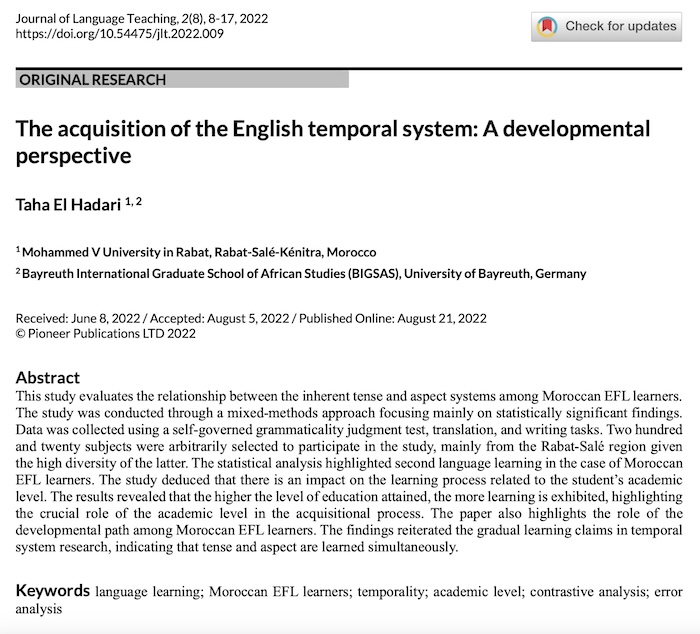The acquisition of the English temporal system: A developmental perspective
DOI:
https://doi.org/10.54475/jlt.2022.009Keywords:
language learning, Moroccan EFL learners, temporality, academic level, contrastive analysis, error analysisAbstract
This study evaluates the relationship between the inherent tense and aspect systems among Moroccan EFL learners. The study was conducted through a mixed-methods approach focusing mainly on statistically significant findings. Data was collected using a self-governed grammaticality judgment test, translation, and writing tasks. Two hundred and twenty subjects were arbitrarily selected to participate in the study, mainly from the Rabat-Salé region given the high diversity of the latter. The statistical analysis highlighted second language learning in the case of Moroccan EFL learners. The study deduced that there is an impact on the learning process related to the student’s academic level. The results revealed that the higher the level of education attained, the more learning is exhibited, highlighting the crucial role of the academic level in the acquisitional process. The paper also highlights the role of the developmental path among Moroccan EFL learners. The findings reiterated the gradual learning claims in temporal system research, indicating that tense and aspect are learned simultaneously.
References
Alsalmi, M. (2013). Tense and Aspect Acquisition in L2 English by Native speakers of Arabic. Arab World English Journal, 4(2), 270-282.
Shirai, Y., & Andersen, R. W. (1995). The acquisition of tense-aspect morphology: A prototype account. Language, 71(4), 743-762. DOI: https://doi.org/10.2307/415743
Comrie, B. (1976). Aspect: An introduction to the study of verbal aspect and related problems. Cambridge: Cambridge University Press.
Comrie, B. (1985). Tense. Cambridge: Cambridge University Press. DOI: https://doi.org/10.1017/CBO9781139165815
Corder, S. (1967). The Significance of the Learners’ Errors. International Review of Applied Linguistics. DOI: https://doi.org/10.1515/iral.1967.5.1-4.161
Dietrich, R., Klein, W., Noyau, C., & Coenen, J. (1995). The acquisition of temporality in a second language. Philadelphia, Pa: J. Benjamins. DOI: https://doi.org/10.1075/sibil.7
Hamm, F. & Bott, O. (2014). Tense and aspect. Stanford Encyclopedia of Philosophy. Retrieved from https://plato.stanford.edu/entries/tense-aspect/.
Hofmann, T. R. (1993). Realms of meaning: An introduction to semantics. London: Longman.
Huddeleston, R. (1988). English Grammar: An Outline. Cambridge University Press. DOI: https://doi.org/10.1017/CBO9781139166003
Ishida, M. (2004). Effects of recasts on the acquisition of the aspectual form‐te i‐(ru) by learners of Japanese as a foreign language. Language Learning, 54(2), 311-394. https://doi.org/10.1111/j.1467-9922.2004.00257.x DOI: https://doi.org/10.1111/j.1467-9922.2004.00257.x
Jiyad, M. (2010). 101 fundamental Arabic grammar rules: A short reference for Arabic syntactic, morphological and phonological rules for novice and intermediate levels of proficiency. Saarbrucken, Germany Lambert Academic Publishing.
Kecskes, I. (1999). Situation-Bound Utterances from an Interlanguage Perspective. In Jef Verschueren (ed.) Pragmatics in 1998: Selected Papers from the 6th International Pragmatics Conference. (2nd end, pp. 299-310). Antwerp: International Pragmatics Association.
Klein, E. C. (1993). Toward Second Language Acquisition: A Study of Null-Prep. Dordrecht: Kluwer Academic Publishers. DOI: https://doi.org/10.1007/978-94-011-2038-8
Krashen, S. D. (1985). The input hypothesis: Issues and implications. Torrance, CA: Lared.
Lado, R. (1957). Linguistics across cultures: Applied linguistics for language teachers. Ann Arbor, Mich: The University of Michigan Press.
Leech, G. N. (1987). Meaning and the English verb. London: Longman.
Quirk, R. (1985). A comprehensive grammar of the English language. London: Longman.
Ringbom, H. (1994). Contrastive analysis. In R. E. Asher, and J. M. Y. Simpson (eds), Encyclopedia of Linguistics, Vol. 2. Oxford: Pergamon Press, 737-742.
Shirai, Y., & Nishi, Y. (2005). How what we mean impacts how we talk: The Japanese imperfective aspect marker - teiru in conversation. In J. Frodesen & C. Holten (Eds.), The power of context in language learning and teaching (pp. 39-48). Boston, MA: Thomson Heinle.
Tsvetkova, M. (2018). Past-time reference, tense, and aspect. Studies in Linguistics, Culture, and FLT, 4(2), 98-105. https://doi.org/10.46687/SILC.2018.v04.009 DOI: https://doi.org/10.46687/SILC.2018.v04.009
El Hadari. T. (2015). The acquisition of tense and aspect among Moroccan EFL learners: A constraint demotion model. (Unpublished thesis). Mohammed V University of Rabat.
El Hadari. T. (in press). An optimality-theoretic account of the acquisition of English tenses: Moroccan EFL learners. The Journal of Southern African Linguistics and Applied Language Studies. https://10.2989/16073614.2022.2063146

Downloads
Published
Issue
Section
License
Copyright (c) 2022 Journal of Language Teaching

This work is licensed under a Creative Commons Attribution 4.0 International License.





